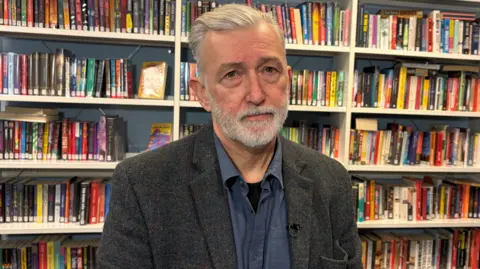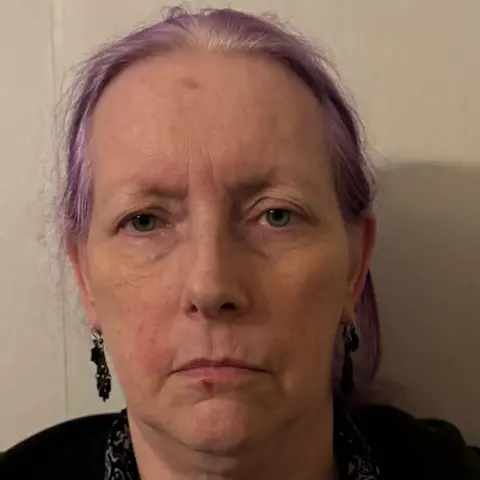Katy McCloskeySenior Producer, Scottish Education
 BBC
BBCTeachers in Scotland are set to vote on industrial action over their work and the time they spend in front of a class.
They say it’s almost five years since the SNP promised to commit to 90 minutes of classroom contact time an hour to prepare teachers such as lesson preparation.
Union bosses say teachers are under unprecedented pressure, suffering from snowballing demands, increasing workloads and, in many cases, burnout.
The situation is not new but teachers have told the BBC it is getting worse, particularly because of the increase in children with additional support needs.
Scotland’s largest union, the EIS, started postal ballots on Wednesday, while the Nasuwt will start from 19 November. SSTA members are expected on the ballot soon.
What do teachers do with an extra 90 minutes?
Most teachers will not speak to the media on the record out of concern that their contracts do not allow it.
However, the BBC spoke to many teachers who are also union reps.
Rod McCrehed is a Nasuwt Rep and physics teacher in Glasgow who has been teaching for over 20 years.
He said that, because of his subject, the marking was easier than others but he needed more time to plan the lessons better.
“Physics can be a complicated subject,” he said.
“You need half a dozen ways to help explain something and you’re waiting for one of those ways to make a kid click, go for it.”
He said that not everyone fits into the class.
“There was one teacher last year who stopped it after three weeks, it was really hard,” he said.
“I was lucky to have a good school. In my work as a union rep, I heard about violence and attacks in the classroom, the pressure was unbelievable.
“If you’re pushed against a wall, that’s 20 minutes out of 40 minutes just to fill out the paperwork.”

Derrick Roberts, who teaches history in the Lochaber area, says he will spend an extra hour and a half from the cut time to adapt lessons for children with additional needs.
He says he now finds himself working at home most of the night.
“Sometimes I rush through evening lessons and weekends trying to get things done,” he said.
“The 90 minutes will allow me to adapt the materials – changing the resources so that they fit in the right place.
“I took my resources to the bank but I didn’t have enough time to adjust it.”
Mr Roberts said he felt less pressure to come to Scotland 13 years ago.
“We’re hoping to do less non-teaching,” he said.
“We’re not chasing every piece of data, we don’t need to know three or four things about every student.”
He said that when he came to teachers in Scotland it was not common to hit the 22.5 hour limit for contact time and there were always one or two periods a week where they could discover.
Now he says that there is a recruitment and application crisis, not enough teachers to supply, many posts that have not been done “, where teachers are asked to fill the partner.
He said many staff are currently teaching at the current 22.5 hour limit.
“An extra 90 minutes a week would allow a wee buffer zone,” he said.

Carol Wood is an ASN (additional support needs) in a specialist unit within a mainstream secondary school in Mray.
He says he will use his extra time to get the title that comes with the job.
“There’s a lot of admin at ASN,” he said.
“There are learning support plans, student plans, individual education plans.
“You should go and observe the children, then write a report on the star.
“The extra time will support a more effective understanding of these students that will help the primary partners understand them better.”
Wood Wood said he also wants to do more training.
“I’ll watch the webinars to see the latest research,” he said.
“It’s all moving quickly at the moment with the Neurodivergent Tourvery Trip and having time to digest the new materials and processes will be great.”
According to the MS tree, he has children of secondary development equal to the primary level.
He said that he can spend a lot of time adapting the worksheets to their needs just so that it occupies a student in 20 minutes.
“Every kid in my class, everyone is the same, has a different need or acquisition,” she said.

Alison Beattie works in “Support for learning” within a leading Primary school in Glasgow.
She takes children outside of the classroom to help them learn, either one-on-one or in groups.
“When I get extra time, I spend it on paperwork and talking to colleagues about support needs,” he said.
Alison said the number of children in her primary school with additional support needs went from 11% two years ago to 60% in May this year.
He says he can see the numbers showing how things have changed.
“That number is realistic,” he said.
“That’s my experience, that’s the needs that come before us.
“Maybe a few years ago maybe it wasn’t as urgent, it was good to have 90 minutes then, but it’s urgent now.”
Alison said there are a variety of needs within her school.
“We get kids with Dyslexia, dyscalculia, autism, adhd, it’s a must,” he said.
“There are also children with multiple abilities. In one classroom you can teach at different levels.
“In P5, P6 and P7, you will now be teaching children at P1 level as well as P5 level and hopefully have lessons that meet all those needs.”
Teacher numbers in 2021
By 2021, the SNP has pledged to increase teacher numbers by 3,500 over the course of the Parliamentary term, which unions say is essential to provide an extra 90 minutes of non-teaching time each week.
At the time, there were 54,285 teachers in Scotland. Last year, the number stood at 53,412.
First minister John Swinney has promised to get numbers back to the 2023 level – 54,033 – so all eyes will be on the annual census statistics statistics next month.
Education experts point out that schools need more staff but also need to be in the right place to provide cover for their extra contact time.
There are also long-term challenges in filling teaching posts in some rural areas and in some secondary specialties.
Teachers are now allotted seven-and-a-half hours a week of preparation time.
Ultimately, it is the councils that employ the teachers and therefore control the numbers.
The Scottish government has several levers it can use to force councils to hire more staff.
Additional funding is needed
A spokesman for COSLA, the group that represents local authorities, said it was disappointed that the teaching unions were moving forward with their consultative balls.
They say there are practical issues in delivering reduced classroom contact time and it will require additional funding to support such a major change.
A Scottish government spokesman said: “Ministers are clear that reducing classroom contact will help support time and the development of our teachers and our pupils.
“We are committed to working with teaching unions and COSLA to agree on our approach to delivering a reduced classroom contact time at Pace.
“Ministers respect the right of union members to withdraw from their work, but are disappointed that EI has taken this action while these discussions are ongoing.”


